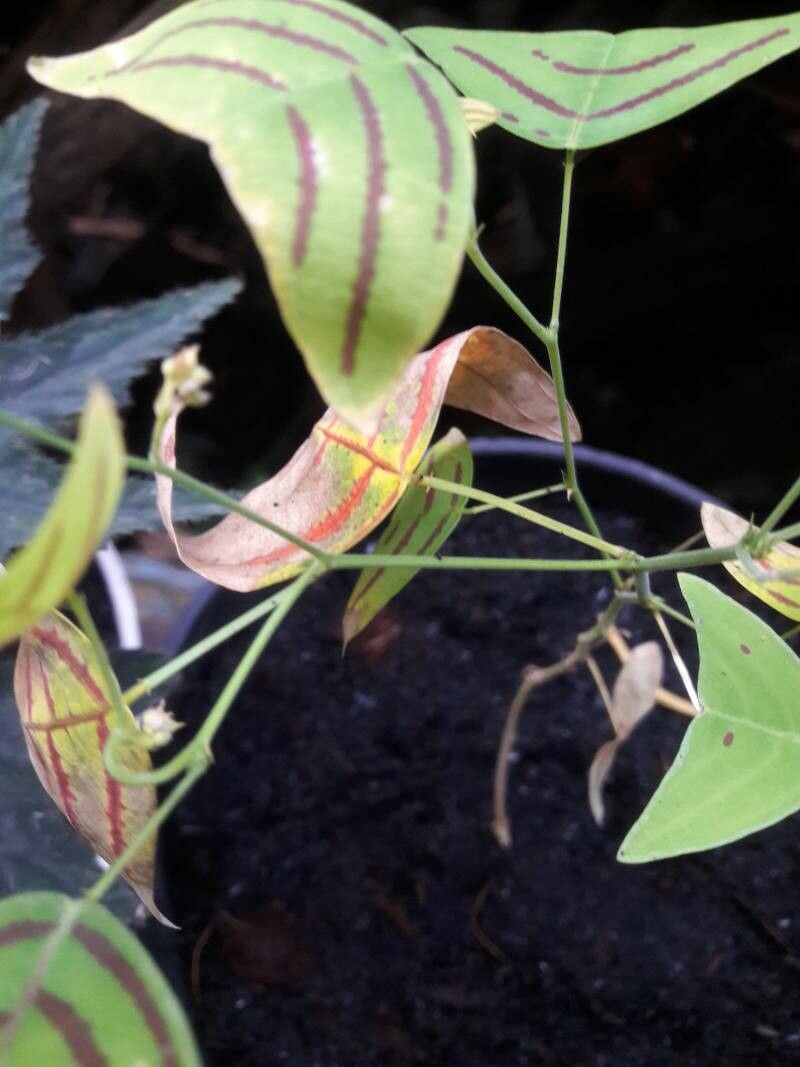Butterfly Wings Plant
christia obcordata
Also known as: ["Wing Plant","Butterfly Leaf Plant"]
Overview
A striking ornamental plant known for its unique butterfly-shaped leaves with vibrant color patterns.
Benefits & Perks
["aesthetic foliage","rare/collector’s item"]
Botanical Classification
| Phylum: | Magnoliophyta |
| Class: | Magnoliopsida |
| Order: | Fabales |
| Family: | Fabaceae |
| Genus: | Christia |
| Botanical Name: | Christia obcordata |
Plant Characteristics
Basic Information
- Category: Leaf Plants
- Suitable Location: indoor pot in bright, filtered light or shaded outdoor garden
- Suitable For:
- Is Weed: No
- Allergenicity: low
Environmental Needs
- Climate: {"temperatureRange":"15–30°C"}
- Hardiness: {"zones":"9–11"}
- Misting: every 2–3 days in dry environments, less often in humid climates
- Drainage: Fast-draining to prevent waterlogging.
- Soil Type: Well-draining potting mix with perlite or sand for aeration.
Maintenance Level
- Maintenance Level: moderate
- Toughness Level: moderate
- Pruning Frequency: As needed, typically every 2–3 months or after flowering.
- Pruning Intensity: Light to moderate; avoid removing more than one-third of foliage at once.
Care Details
Ideal Sunlight Coverage:
Bright indirect light for 6–8 hours daily; adjust for intensity in summer to prevent leaf burn.
Sunlight Tolerance Tips:
Gradually acclimate to brighter light; protect from direct sun; move indoors during extreme heat or cold.
Care Requirements
Care Difficulty
moderateeasy
Sunlight
bright indirect light, partial shade
Rotate plant weekly; use sheer curtains for filtered light; avoid direct afternoon sun.
Watering
every 7–10 days during active growth, reduce in winter
Water deeply but infrequently; ensure proper drainage; adjust based on season and humidity.
Soil
well-draining, peat-based potting mix
pH: Slightly acidic to neutral (pH 6.0–7.0).
Ensure pots have drainage holes; avoid heavy clay soils; top-dress with compost annually.
Temperature
Prefers 65–75°F (18–24°C); tolerates 50–85°F (10–29°C) with protection from extremes.
Avoid sudden temperature changes; protect from drafts; maintain moderate humidity.
Fertilizing
every 2 weeks during growing season, monthly in spring and fall, none in winter
Fertilize only when actively growing; flush soil occasionally to prevent salt buildup; avoid over-fertilizing.
Propagation
Methods
Stem cuttings in water or soil.
Step-by-Step Propagation Guide
- Select healthy stem, cut below node, remove lower leaves, place in medium, maintain moisture.
Best Time: Spring or early summer when the plant is actively growing.
Environment
Warm, humid, and bright indirect light with protection from direct sun.
Medium
Well-draining potting mix or water with occasional root hormone application.
Hormone
Optional but recommended for faster rooting.
Timeline
Roots in 2–4 weeks; new growth in 6–8 weeks.
Tools Needed
Pruning shears, rooting hormone, small pot, well-draining mix.
Quick Tips
Use healthy, non-flowering stems; keep medium consistently moist; provide bottom heat for faster rooting.
Pruning & Repotting
Pruning Guide
Method
Pinch back tips or cut just above a leaf node to promote branching.
Pruning Plan
Remove leggy growth, encourage bushier form, and maintain shape.
Tools
Clean, sharp pruning shears or scissors.
Checklist
Sanitize tools, prune dead/damaged growth, shape plant, clean up debris.
Repotting Guide
Best Season
Spring, before the active growing season begins.
Pot Size
Choose a pot 1–2 inches larger in diameter than the current one.
Method
Remove plant gently, trim roots if needed, place in new pot with fresh soil, water lightly.
Suggestions
Repot every 1–2 years or when roots outgrow the pot; refresh soil to maintain vigor.
Checklist
Check root bound status, prepare new pot, trim roots, add fresh soil, water lightly.
Advanced Care Tips
Watering Mastery
Watering Checklist
Check soil moisture, water thoroughly, ensure drainage, adjust for season.
How to Apply Water Properly
Water directly at the root zone until water drains from the bottom; avoid wetting foliage; water in the morning for optimal absorption.
Watering Schedule Tips
Water thoroughly when the top inch of soil feels dry; reduce frequency in winter to prevent root rot.
Soil Improvement
Add perlite or coarse sand to improve drainage; incorporate organic matter for fertility.
Temperature Stress Management
Signs of Temperature Issues
Wilting, leaf drop, or chlorosis in cold; scorching or stunted growth in heat.
Cold Stress
Slows growth, causes leaf drop, and may lead to root rot in prolonged cold.
Solution: Move to a warmer spot; insulate pot; avoid cold drafts; reduce watering.
Hot Stress
Leaves may scorch, wilt, or drop; growth may stall in excessive heat.
Solution: Provide shade; increase humidity; water more frequently; ensure good air circulation.
Fertilizing Guide
Fertilizing Checklist
Check growth phase, dilute fertilizer, apply to moist soil, avoid foliage contact.
Fertilizing Method
Use balanced liquid fertilizer diluted to half strength every 4–6 weeks during growing season (spring/summer); cease in fall/winter.
Common Problems & Solutions
Toxicity Warning
Cats
Non-toxicChristia obcordata is not known to be toxic to cats. It does not produce any known harmful compounds that would affect feline health.
⚡ Toxic If:
if eaten
Dogs
Non-toxicChristia obcordata is not known to be toxic to dogs. It does not produce any known harmful compounds that would affect canine health.
⚡ Toxic If:
if eaten
Humans
Non-toxicChristia obcordata is not known to exhibit toxic effects in humans. It is generally considered safe for handling and consumption.
⚡ Toxic If:
if eaten
Frequently Asked Questions
Q: How often should I water Christia obcordata?
A: Water when the top inch of soil feels dry, typically every 7-10 days, depending on conditions.
Q: Does this plant require direct sunlight?
A: It thrives in bright, indirect light but can tolerate some direct morning sun.
Q: Is Christia obcordata suitable for indoor growing?
A: Yes, it is well-suited for indoor environments with adequate light and humidity.
Quick Reference
| Family: | Fabaceae |
| Care: | moderate |
| Light: | bright indirect light, partial |
| Water: | every 7–10 days during activ |
Get Expert Care Tips
Download the Plantious app for personalized care reminders and plant identification!
Google Play App Store





